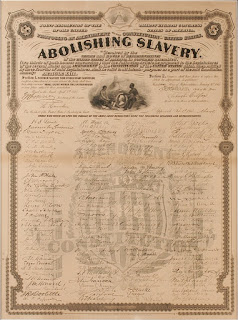 |
| Abolishing Slavery Banner |
December, 6th is a special date in The USA. American people celebrate two big events: for one hand, the 13th Amendment (1865), for other hand, the end of the construction of George Washington Monument in DC.
Tina Picotes, who is travelling around the States and today is visiting Washington, D.C., wants to talk to us about these two events. She invites us to read two posts from History.com, a webpage that she recommends fervently. It's a must, if you like History.
Neither slavery nor involuntary servitude, except as a punishment for crime whereof the party shall have been duly convicted, shall exist within the United States, or any place subject to their jurisdiction.
On this day in 1865, the 13th Amendment to the U.S. Constitution, officially ending the institution of slavery, is ratified. With these words, the single greatest change wrought by the Civil War was officially noted in the Constitution.
More information: History.Net
The ratification came eight months after the end of the war, but it represented the culmination of the struggle against slavery. When the war began,some in the North were against fighting what they saw as a crusade to end slavery. Although many northern Democrats and conservative Republicans were opposed to slavery’s expansion, they were ambivalent about outlawing the institution entirely. The war’s escalation after the First Battle of Bull Run, Virginia, in July 1861 caused many to rethink the role that slavery played in creating the conflict.
 |
| Slave family. Cotton workers. Georgia, 1860 |
By 1862, Lincoln realized that it was folly to wage such a bloody war without plans to eliminate slavery. In September 1862, following the Union victory at the Battle of Antietam in Maryland, Lincoln issued the Emancipation Proclamation, declaring that all slaves in territory still in rebellion on January 1, 1863, would be declared forever free. The move was largely symbolic, as it only freed slaves in areas outside of Union control, but it changed the conlfict from a war for the reunification of the states to a war whose objectives includedthe destruction of slavery.
Lincoln believed that a constitutional amendment was necessary to ensure the end of slavery. In 1864, Congress debated several proposals. Some insisted on including provisions to prevent discrimination against blacks, but the Senate Judiciary Committee provided the eventual language. It borrowed from the Northwest Ordinance of 1787, when slavery was banned from the area north of the Ohio River. The Senate passed the amendment in April 1864.
More information: 13th Amendment to the U.S. Constitution (Chronology)
A Republican victory in the 1864 presidential election would guarantee the success of the amendment. The Republican platform called for the utter and complete destruction of slavery, while the Democrats favored restoration of states’ rights, which would include at least the possibility for the states to maintain slavery. Lincoln’s overwhelming victory set in motion the events leading to ratification of the amendment. The House passed the measure in January 1865 and it was sent to the states for ratification. When Georgia ratified it on December 6, 1865, the institution of slavery officially ceased to exist in the United States.
Roll Jordan, roll. Roll Jordan, roll
I want to get to heaven when I diet to hear Roll Jordan roll
I want to get to heaven when I diet to hear Roll Jordan roll
John Legend
 |
| Construction of Washington Monument |
Nineteen years later, on this same day, in Washington, DC, workers place a nine-inch aluminum pyramid atop a tower of white marble, completing the construction of an impressive monument to the city’s namesake and the nation’s first president, George Washington.
As early as 1783, the infant U.S. Congress decided that a statue of George Washington, the great Revolutionary War general, should be placed near the site of the new Congressional building, wherever it might be. After then, President Washington asked him to lay out a new federal capital on the Potomac River in 1791, architect Pierre L’Enfant left a place for the statue at the western end of the sweeping National Mall, near the monument’s present location.
It wasn’t until 1832, however, 33 years after Washington’s death, that anyone really did anything about the monument. That year, a private Washington National Monument Society was formed. After holding a design competition and choosing an elaborate Greek temple-like design by architect Robert Mills, the society began a fundraising drive to raise money for the statue’s construction.
These efforts, including appeals to the nation’s schoolchildren, raised some $230,000, far short of the $1 million needed. Construction began anyway, on July 4, 1848, as representatives of the society laid the cornerstone of the monument: a 24,500-pound block of pure white marble.
 |
| Workers on the top of Washington Monument |
Made of some 36,000 blocks of marble and granite stacked 555 feet in the air, the monument was the tallest structure in the world at the time of its completion in December 1884. In the six months following the dedication ceremony, over 10,000 people climbed the nearly 900 steps to the top of the Washington Monument.
Today, an elevator makes the trip far easier, and more than 800,000 people visit the monument each year. A city law passed in 1910 restricted the height of new buildings to ensure that the monument will remain the tallest structure in Washington, D.C., a fitting tribute to the man known as the Father of His Country.
The time is near at hand which must determine whether Americans are to be free men or slaves.
George Washington
No comments:
Post a Comment